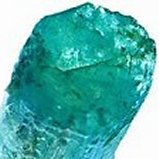
Aquamarine is a pale blue transparent beryl with hints of yellow, green, or brown. Green stones used to be preferred, but blue is currently more popular. The darker-blue of modern aquamarine is created artificially by heat-treating paler, greener crystals. The process requires temperatures of 800 F to suppress the yellow tinge.
Once considered a sacred stone, its name means “water of the sea,” and Roman fishermen used it for protection on water and to bring in a good catch. Roman physicians prescribed it to treat overindulgence, headache and neck trouble, and water retention. Like Amethyst (see Quartz), Aquamarine was inlaid in goblets for use as a purifier. During the Middle Ages, it was said that if a person held Aquamarine in their mouth, they could summon the Devil from Hell and receive answers to any questions they asked. More recently, aquamarine has been considered a stone of djinni who must fulfill the wish of anyone wearing the stone. It has been suggested for use by students to help studying and enhance concentration, and to increase psychic ability.
This form of beryl fosters acceptance of the transient nature of physical experience. The deep oceanic shades of aqua are best for transmutative purposes, and may ease us through the process of death. This stone offers protection and courage. Pale blue or blue-green stones afford the wearer soothing and calmness.
Aquamarine is the ultimate water divination stone: Place it in a crystal bowl filled with pure, natural spring water. Gaze deeply into the bowl and allow the images engendered through the stone to flow freely into consciousness.
Drink auamirine water as a tonic, to enhance psychic awareness and mental clarity.
Aquamarine, which is a pale blue-green colored variety of beryl, is an attractive mineral that is classified as a cyclosilicate. It is composed of Beryllium Aluminum Silicate, but with trace impurities of iron compounds — these impart its subtle coloration. Most commercial specimens, however, have been heat treated to change them from pale yellow to blue green, or to enhance and deepen existing colors. It has a vitreous luster, and is often associated with calcite, mica, quartz, tourmaline, and some varieties of feldspar. Aquamarine is popular with collectors, especially when it is part of a larger and more interesting mineral specimen. It has a white streak.